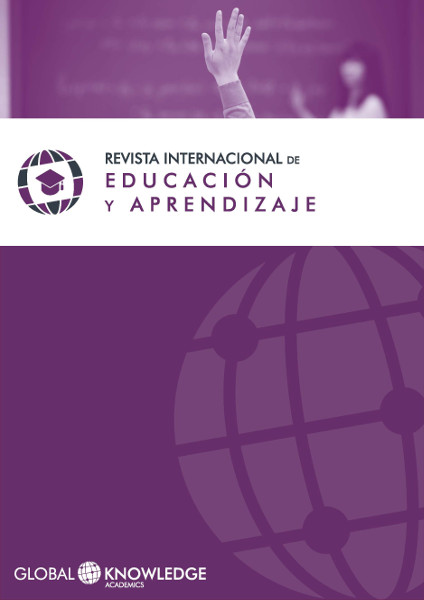Tutorial Videos, an Alternative Study for Students: Level of Self-Learning and Motivations
DOI:
https://doi.org/10.37467/gka-revedu.v5.1391Keywords:
Technology Acceptance, Motivations, Education, Learning, Technologies, Educational Model, Student Community, Full DevelopmentAbstract
Education is a fundamental topic if we want to achieve a full development. This article has as aim to investigate trough empirical studies; the motivational factors that stimulate the students to use technological tools as a way of learning, thus looking at the influence of the methodologies of education used by the teachers. All to have a clearer perspective of the introduction of technological acceptance in education. Technological revolution and mayor access to internet have opened up new platforms as educational alternatives to the shortcomings of the traditional educational model, thus allowing greater autonomy of learning and reduction of cots in educational matters.
Downloads
Global Statistics ℹ️
|
2211
Views
|
572
Downloads
|
|
2783
Total
|
|
References
Aguilar, M. G., Campos, S. R., & Batlle, P. F. (2012). El uso académico de las redes sociales en universitarios. Comunicar, 19(38), 131-138. DOI: https://doi.org/10.3916/C38-2012-03-04
Azucena, G, Fierro, S. y Landeros H. (2015). Elementos de la comunicación visual a considerar en el desarrollo de material didáctico digital. Volumen 2, Número 1, 2015, 17-25. DOI: https://doi.org/10.37467/gka-revedutech.v2.961
Bates, A. W. (1999). La tecnología en la enseñanza abierta y la educación a distancia. Trillas.
Brunner, J. J., Elacqua, G., Tillett, A., Bonnefoy, J., González, S., Pacheco, P., & Salazar, F. (2015). Guiar el mercado. Informe sobre la educación superior en Chile.
Burke, S. C., & Snyder, S. L. (2008). YouTube: an innovative learning resource for college health education courses. International Electronic Journal of Health Education, 11, 39-46.
Castillo, S. S. (2012). La adquisición de competencias mediante la autonomía en el proceso de aprendizaje autorregulado. Estudios sobre el mensaje periodísticos, Vol. 18 Pag. 850. DOI: https://doi.org/10.5209/rev_ESMP.2012.v18.40963
Choi, Á., & Calero, J. (2012). Rendimiento académico y titularidad de centro en España.
De Haro, J. J. (2010). Redes sociales para la educación. Ponencia Uso educativo de las.
Fermoso, P., & Fermoso, J. (1997). Manual de economía de la educación. Narcea Ediciones.
Lee, D. Y., & Lehto, M. R. (2013). User acceptance of YouTube for procedural learning: An extension of the Technology Acceptance Model. Computers & Education, 61, 193-208. DOI: https://doi.org/10.1016/j.compedu.2012.10.001
López, L. P. C. (2009). El cibersalón: Educación superior y YouTube. Chasqui. Revista Latinoamericana de Comunicación, (106).
Montico, S. (2004). La motivación en el aula universitaria: ¿una necesidad pedagógica? Ciencia, Docencia y Tecnología, 15(29), 105-112.
Müller P. y Vera N. (2015). Cambio de un sistema educativo de presencial a virtual: componente cognitivo y motivacional de los alumnos. Revista internacional de aprendizaje y cibersociedad. Vol. 19 Número 1. DOI: https://doi.org/10.37467/gka-revciber.v19.878
Odriozola, E. E., & de Corral Gargallo, P. (2010). Adicción a las nuevas tecnologías ya las redes sociales en jóvenes: un nuevo reto. Adicciones: Revista de socidrogalcohol, 22(2), 91-96. DOI: https://doi.org/10.20882/adicciones.196
Ortiz, R., Vargas, X. (2015). Revista Internacional de Pedagogía y Currículo, 2(1), 2015, pp.37-47.
Rubio Moraga, Á. L. (2003). Internet y Enseñanza: la educación virtual.
Scagnoli, N. I. (2005). Estrategias para motivar el aprendizaje colaborativo en cursos a distancia.
Terrón, F. J. M. (2011). Coaching educativo y académico: un nuevo modo de enseñar y aprender. Educación y Futuro: Revista de investigación aplicada y experiencias educativas, (24), 49-66.
Downloads
Published
How to Cite
Issue
Section
License
Those authors who publish in this journal accept the following terms:
-
Authors retain copyright.
-
Authors transfer to the journal the right of first publication. The journal also owns the publishing rights.
-
All published contents are governed by an Attribution-NoDerivatives 4.0 International License.
Access the informative version and legal text of the license. By virtue of this, third parties are allowed to use what is published as long as they mention the authorship of the work and the first publication in this journal. If you transform the material, you may not distribute the modified work. -
Authors may make other independent and additional contractual arrangements for non-exclusive distribution of the version of the article published in this journal (e.g., inclusion in an institutional repository or publication in a book) as long as they clearly indicate that the work was first published in this journal.
- Authors are allowed and recommended to publish their work on the Internet (for example on institutional and personal websites), following the publication of, and referencing the journal, as this could lead to constructive exchanges and a more extensive and quick circulation of published works (see The Effect of Open Access).













